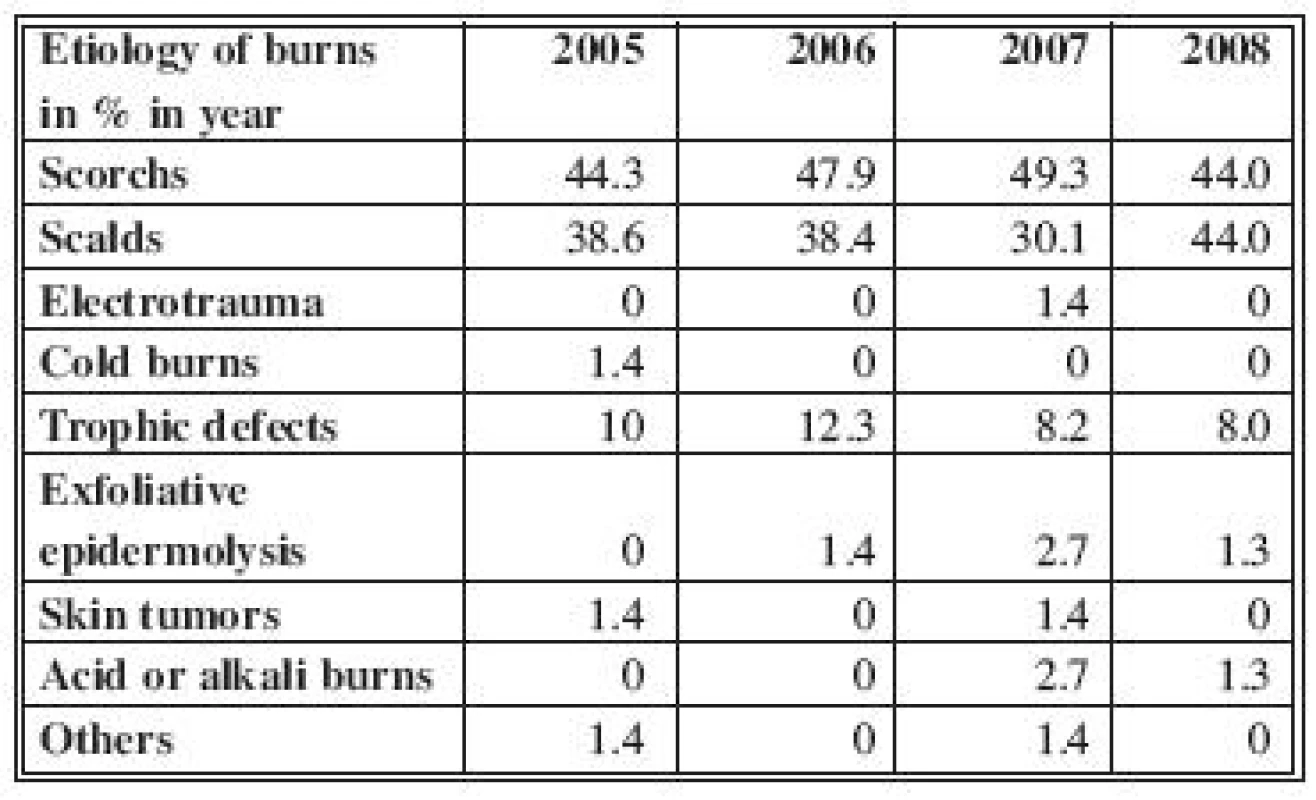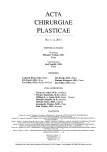-
Medical journals
- Career
Epidemiology of Burn Injuries in Geriatric Patients in the Prague Burn Centre During the Period 2005–2008
Authors: M. Tokarik; E. Jančušková; L. Brož
Authors‘ workplace: Prague Burn Centre, Third Faculty of Medicine, Charles University Prague, Czech Republic
Published in: ACTA CHIRURGIAE PLASTICAE, 53, 1-4, 2011, pp. 25-28
INTRODUCTION
Although thermal injuries are less common than others, and their frequency remains the same, their after-effects – such as mortality, permanent damage and long, painful and expensive treatment – are among the worst of all injuries. Therefore it is very important to concentrate not only on treatment but also on prevention and the provision of adequate first aid.
MATERIAL AND METHODS
Every year about 1% of the population is treated for some kind of burn injury. 97% of them are outpatients, while about 3% have to be admitted to hospital. Over the last five years senior citizens over the age of 65 have constituted more than 12% of all patients admitted to the Prague Burn Centre. There were about a third more females than males. The demographic situation in Czech Republic suggests that the number of senior citizens has been growing each year since 2002. According to the STEM Agency (Centre of Empiric Research), from 2006 our population has been defined as regressive, with elderly women over-represented. The proportion of elderly people above 60 is now constant at 18%, but according to the demographical prognosis it will start to grow. We can assume that this group represents a very important sector of the population, which will grow bigger and whose needs are specific.
RESULTS
The average age of senior citizens admitted for treatment from 2005 to 2008 has increased (Graph 1).
Graph 1. The average age of admitted seniors 
Prague Burn Centre is the oldest and biggest burn superconsultant workplace in the Czech Republic, with a catchment area comprising the whole of Bohemia, home to approximately seven million people.
The age structure of the senior citizens hospitalized in the Prague Burn Centre between 2005 and 2008 is indicated in Graph 2. People from 65 to 85 are the largest group. The lower number of people over 85 years of age corresponds to the smaller lower number of elderly people above that age. 291 senior citizens were hospitalized in the Prague Burn Centre from 2005 to 2008; the female to male ratio was 1 : 0.77.
Graph 2. The age structure of hospitalized seniors 
The specific causal factors of burns to senior citizens are the physical (immobility, locomotive dyscoordination), the psychological (anxiety, involutional depression, resignation, dementia) and health anamnesis (cardiovascular, respiratory, metabolic, neurological co-morbidities) (1, 2). Graph 3 shows the occurrence of cardiovascular diseases (ischemic heart disease, hypertension), diabetes mellitus, the most frequent neurological diseases (cerebrovascular dementia, morbus Alzheimer, epilepsy) chronic corticotherapy in our patients. The most frequent causes of mortality are prolonged burn shock, heart failure, pulmonary embolism, sepsis – multiple organ dysfunction – failure (Table 1). It is apparent that the most common comorbidity factors in our patients were diseases of the cardiovascular system. Prolonged burn shock, heart failure and lung embolism are the most frequent causes of death.
Graph 3. Occurrence of the associated diseases 
The most common mechanism of burn injuries in seniors are the scorches and scalds (Fig. 1–3), while other relatively frequent causes are the non-thermal (trophic defects, skin tumors or general skin bullate affections such as exfoliative epidermolysis) – Table 2, Graph 4.
Fig. 2. Burns of the dorsal parts of the legs of the II<sup>nd</sup> – III<sup>rd</sup> degree 
Fig. 3. Scalds of the dorsal parts of legs and buttocks of the II<sup>nd</sup> degree 
2. Etiology of burns in seniors 
Graph 4. Etiology of burns in seniors 
Severity of burn injuries is determined by the location. The locations with the highest risk are the head, neck, genitals and inhalatory trauma (Graph 5).
Graph 5. Incidence of burns localizations 
The most consequential prognostic factors determining the severity of burn injuries are the extent (Table 3, Graph 6) and the depth of burns (Graph 7).
The most common injuries are up to 5% of the body surface area (TBSA). However, we should note that injuries above 15% of TBSA comprise about 30% of cases. The most frequent depth is IIb.
The most common therapy is necrectomy with autotransplantation. Xenotransplantation was used till 2005 (Table 4, Graph 8). Average time before arrival for special treatment was 1.15 days. The average length of hospital stay during 2005–2008 was 27.66 days (Graph 9).
Graph 9. Average length of hospital stay 
DISCUSSION
According to demographic research, the population is getting older. Because the subpopulation of seniors will grow in the coming years, it is crucial to create and put into practice systematic methods of prevention of thermal injuries. The senior population is a specific group characterized by polymorbidity and impaired course of healing. One very frequent problem is to establish whether the injury is the cause or result of another disease. About 20 % of thermal injuries result from inadequate safety provisions in the home. The kitchen, bathroom and garden are the most high-risk places. The prevention of injuries of this sort, in the home, entails a complex of structural changes, the usage of protective instruments and procedures, and the education of family members. Procedures to reduce the dangers of post-traumatic effects need not be overly complex: cooling and timely transport to a facility offering special treatment is sufficient. As many of 65% of senior citizens who suffer such injuries are capable of resuming an independent lifestyle afterwards.
CONCLUSIONS
291 senior citizens were hospitalized in the Prague Burn Centre from 2005 to 2008; the female to male ratio was 1 : 0.77. The average age of people who were admitted increased from 70 to 75 without an increase in mortality. The etiology of burns, their localizations and depth, TBSA distribution, the occurrence of associated diseases and average hospital stay did not show any significant variation throughout the period of 2005 to 2008. We can observe a significant increase in the use of radical surgery methods (p > 0.10), necrectomy and auto-transplantation in comparison with conservative methods. This correlates with a mild rise in III degree burns.
Address for correspondence:
Monika Tokarik, M.D.
Prague Burn Centre, Third Faculty of Medicine,
Charles University Prague
Faculty Hospital Královské Vinohrady
Šrobárova 50
100 34 Prague 10
Czech Republic
E-mail: tokarik@fnkv.cz
Sources
1. Brož L. Popáleniny u seniorů, Česká geriatrická revue, 1/2008, p. 48–51.
2. Wong P. Elderly burn prevention: A novel epidemiological approach, Burns, 33, 2007, p. 995–1000.
Labels
Plastic surgery Orthopaedics Burns medicine Traumatology
Article was published inActa chirurgiae plasticae

2011 Issue 1-4-
All articles in this issue
- Czech Summaries
- The Effect of Primary Suture In Cleft Lip On Healing of the Surgical Wound And the Role of Matrix Metalloproteinases
- Posterior Tibial Artery Abnormality and the Role of CT-angiography in Planning Free Flap Transfer for Management of Chronic Osteomyelitis of Tibia: Case Report
- Epidemiology of Burn Injuries in Geriatric Patients in the Prague Burn Centre During the Period 2005–2008
- CARS 2012 – Computer Assisted Radiology and Surgery – 26th International Congress and Exhibition
- Arterialization of the Venous Network as a Solution to Obstructed Arterial System During Replantation
- Structured Light Tridimensional Assessment of Lower Eyelid Ectropion: A New Technique
- 7th Congress of the International Federation of Facial Plastic Surgery Societies 2012 (IFFPSS 2012)
- Index Acta Chir. Plast. Vol. 53, 2011
- Our Experience With Tissue Expansion In The Reconstruction of Burned Children
- Acta chirurgiae plasticae
- Journal archive
- Current issue
- Online only
- About the journal
Most read in this issue- Arterialization of the Venous Network as a Solution to Obstructed Arterial System During Replantation
- Our Experience With Tissue Expansion In The Reconstruction of Burned Children
- Structured Light Tridimensional Assessment of Lower Eyelid Ectropion: A New Technique
- Epidemiology of Burn Injuries in Geriatric Patients in the Prague Burn Centre During the Period 2005–2008
Login#ADS_BOTTOM_SCRIPTS#Forgotten passwordEnter the email address that you registered with. We will send you instructions on how to set a new password.
- Career








